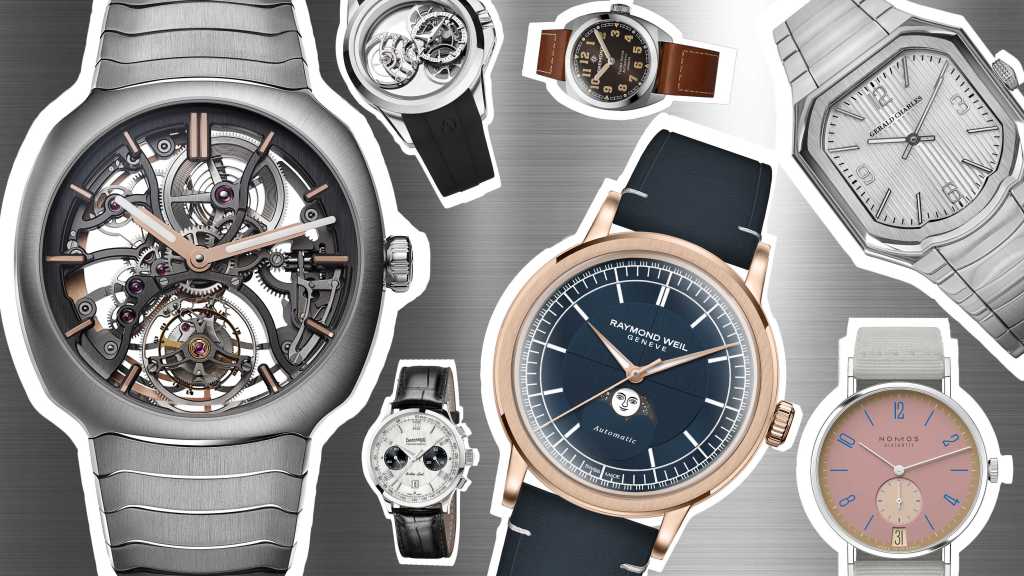From ace pilots and the “maestro” of watchmaking to the use of unconventional materials and a mountaineering bent, these eight independent brands are adding their voices to the mix at the 2024 edition of Watches and Wonders.
H. Moser & Cie
With irreverent creations covered in living plants or mimicking the look of a smartphone rebooting, 196-year-old watchmaker H. Moser & Cie barely needs an introduction as it returns to Watches and Wonders after skipping the 2023 edition.
It brings a clutch of new designs, starting with the 40-mm Streamliner Tourbillon Skeleton remarkable for its symmetry, and a pair of Pioneer Centre Seconds unveiled last week. There’s the Concept Citrus Green, a bracing hue that epitomizes the “life’s too short for meh watches” statement that accompanied its launch, and a slightly more demure Cosmic Green 40-mm.
The label founded in 1828 by Heinrich Moser and relaunched in 2005 isn’t afraid to push boundaries. No indices, no logo and sometimes even no dial — the one on its 2022 “Blacker Than Black” was coated in Vantablack so seemed to vanish into thin air — are all fair game.
Congruent with its motto of “Very Rare,” around 3,000 watches come out of its ateliers in Neuhausen-am-Rheinfall, which manufactures the 18 in-house calibers in its catalogue. Since 2012, the company has been under the umbrella of MELB Holding, formed by industry veteran and former Audemars Piguet chief executive officer Georges-Henri Meylan.

Though the brand is adamant to let its watches do the talking (which got another comedic twist in a video featuring CEO Edouard Meylan and a timepiece trying to resist The Ad Man), it has recently signed on to be the first global partner of Formula One racing team Alpine Motorsports and inked another follow-up deal with French driver Pierre Gasly, the first ambassador in the brand’s history.
H. Moser & Cie has recently launched its own certified pre-owned offer, which includes watches from previous collections. Timepieces sold through this channel are fully serviced and come with a two-year guarantee.
Bremont
Although established in 2002, the story of British watchmaker Bremont started in the late ’90s somewhere above France when brothers Nick and Giles English ran into foul weather in their 1930s biplane, forcing them into an emergency landing.
They were taken in by the kindly owner of the field they had landed in, a gifted engineer who’d flown aircrafts during World War II named Antoine Bremont.
In his house were dozens of half-restored wall clocks and even more engine parts, which echoed their childhood making and restoring at the knee of their late father, an ex-Royal Air Force pilot who held a PhD in aeronautical engineering and who was passionate about mechanical timepieces.
Based in Henley-on-Thames, the brand built its reputation on rugged timepieces with an avionic inspiration, attracting military-minded customers to its designs themed around the sea, land and air. Prices of its timepieces start under 3,000 euros and stay within the four-figure bracket.
It became the only watchmaker to be “Made in England” on an industrial scale with the 2021 inauguration of “The Wing,” its manufacturing and technology center.
The 22-year-old brand took a new step in 2023, first with a $59 million investment from hedge fund manager Bill Ackman, who is a client and used his own funds, and existing investor Hellcat Acquisitions. Then came the July nomination of industry veteran Davide Cerrato as CEO. The moves are expected to see the brand significantly scale up production, put at around 10,000 units a year.
Bremont is the exclusive watch provider for the British Ministry of Defense and its timepieces have even gone through a live ejection testing program. It has also created custom models for some 400 military units around the world, based on existing designs.
The brand got its turn as a silver-screen action hero, creating three custom designs for the British agents of “Kingsman: The Secret Service” movie. Not only did cofounder Nick English feature in the flick, but 1,100 editions were available for sale to the public during the 2014 release.
Raymond Weil
For Raymond Weil, being accessible in price and availability isn’t a bad thing. Nor does it mean skimping on technical know-how.
Case in point: the brand’s Millesime 2930 automatic small seconds watch won the Challenge prize at last year’s Grand Prix de l’Horlogerie de Genève, a prize that recognizes timepieces priced under 3,500 Swiss francs.
This is the crowning achievement for a brand built on the idea that one could offer a Swiss-made watch with a high-quality movement and handsome features at entry-level prices.
Weil, who passed away aged 87 in 2014, launched the brand in 1976 at the midway point of the quartz crisis, when the Swiss industry was floundering in the face of strong competition from Asia that brought inexpensive electronic watch movements.

According to a 2011 interview, Weil sold his first designs — quartz and mechanical watches — off a foldout bridge table in a slip of a booth at Baselworld, gambling that his idea would resonate that the “union of design and technicality makes a product incredibly captivating and interesting.”
The founder’s passion for music saw timepieces named Amadeus, Saxo and Maestro and that connection continues to this day with collaborations with The Beatles, the David Bowie Estate, Bob Marley’s House of Marley and British manufacturer Marshall Amplification.
By the late 1980s, the brand had carved a space for itself as an everyman watch while remaining independent and family-owned, with Weil’s son-in-law Olivier Bernheim helming its international development.
Elie Bernheim, now the CEO and third generation at the helm of the family brand, joined in 2005 and has since been steering it in a more sophisticated direction, with watch enthusiasts as a target.
For its Watches and Wonders debut, Raymond Weil will be bringing out 11 new references of the Millesime line, priced between 1,575 Swiss francs and 3,500 Swiss francs, ranging from its GPHG winner and 35-mm case with a more feminine slant to a Tri-Compax panda-style chronograph and a chic moonphase with central seconds.
Nomos Glashütte
When Roland Schwertner founded Nomos in 1990, the town of Glashütte, considered the birthplace of German watchmaking, had only recently become accessible again to the Western world thanks to the fall of the Berlin Wall eight weeks earlier.
But this IT specialist and photographer based in the German city of Düsseldorf already had the ambition of making high-quality yet accessible timepieces rooted in his homeland’s historic watchmaking epicenter. The idea paid off: the company he founded is now the largest producer of German watches.
The first four models came out in 1992 and included the Tangente, which has since become a brand classic. The watches made an impact with their clean, unfussy lines and Bauhaus-inspired typography, a sign of the fledgling brand’s adherence to the function-first principles of the Deutscher Werkbund association.
The first in-house movement came out in 2005 but the major milestone for the brand was the 2014 reveal of its in-house escapement. Not only did this put Nomos among the handful of brands that can produce their own but it also broke the company’s reliance on Swiss-made movements. Nowadays, the vertical integration of the German watchmaker is around 95 percent across its 15 lines.

On a wall at its headquarters, the number of prizes Nomos has won is tallied in chalk. They now number more than 160 and range from nearly 40 wins of the Goldene Unruh award handed out by prominent German magazines and 11 Reddot Design Awards to the Challenge Prize won at the 2018 Grand Prix de l’Horlogerie de Genève for its Tangente Update model.
Despite the introduction of gold watches in 2013, the brand continues to stick to its accessible ethos. Prices start around 1,200 euros for a two-hand 33-mm Ludwig with a manual-wind Alpha.2 caliber to over 15,000 euros for the 18-karat white gold tonneau-shaped Lux embarking the in-house DUW 2002 caliber.
For this year’s fair, the brand will be releasing no less than 31 colorways of the Tangente 38 date – 175 Years Watchmaking Glashütte. With names like “Super Sardine,” “Lemonbiscuit” and “Pompadour,” this limited-edition run embarking the DUW 4101 caliber is priced lower than the standard model. “The joy of mechanical watches should be accessible to as many people as possible,” stated the brand.
Gerald Charles
Ask anyone in the watchmaking industry and most will agree there is no designer more prolific or influential than Gérald Charles Genta.
The watches he designed, beginning with his first at the age of 23 with the Polerouter he created for Universal Génève, are icons for brands and on the holy grail wish lists of enthusiasts.
With Gerald Charles, it’s Genta’s final act that comes to the fair for the first time.
In 2000 and aged 69, Genta founded the new label to express himself independently once more, after his eponymous Gérald Genta brand — nowadays an unrelated label incubated under La Fabrique du Temps Louis Vuitton — changed hands twice.
Investors, including the Ziviani family, came on board in 2003 and Genta stayed on as designer in chief until his death in 2011.
Among the designs that came out is the “Maestro,” with an octagonal case with a rounded “smile” on the lower edge that nods to the Baroque structures of Swiss-born Italian architect Francesco Borromini.
In 2018, Gerald Charles was reinvigorated with the arrival of Federico Zivani as general manager, with the Maestro as its flagship model. It released a 252-piece run of the Maestro Anniversary in 2020, to mark the number of months since its creation, and named designer Octavio Garcia, an Audemars Piguet veteran of 12 years, as creative director a year later.

The brand, which is stocked in some 50 points of sale globally including Mr. Porter, Arije and London Jewelers, produces around 2,000 watches a year. Prices range between 16,000 euros for a steel three-hand automatic model and go up to 160,000 euros for the limited-edition skeleton version set with emeralds designed by Garcia.
All eyes will be on Masterlink, the latest evolution of the Maestro case that was four years in the making. Garcia, who worked alongside Genta, created an integrated bracelet that seamlessly follows the shape of the case.
ArtyA
Yvan Arpa is not the regular watch industry type, but more an art-and-life enthusiast with a previous career as a mathematician who along the way found in watchmaking his medium of choice.
There’s little conventionalism to be expected from his creations for the ArtyA brand, which he founded in 2009, blending his name with the term art, after having consulted for a range of Swiss luxury watchmakers including Baume & Mercier and Hublot.
In the year marking the company’s 15th anniversary, ArtyA is attending Watches and Wonders for the first time with a design that the company bills as a “return to essentials.”
The brand, based in central Geneva, may have accrued recognition for its “Son of” collections — which included watches with dials made from unconventional materials such as real bullets, stones, real shredded euros, steel drenched in Arpa’s blood or in motor oil, as well as butterfly wings (in compliance with local authorities’ permits) — but it reached new manufacturing heights with its Purity lineup unveiled in 2021 as part of its Complications collection, which already counts three tourbillons.
Hinged on spotlighting the contrast of aesthetic simplicity and technical complexity, via transparency, ArtyA’s “Purity Stairway to Heaven” design is a 40-mm stainless-steel or ceramic double-barrel mechanical watch featuring a minimalist, skeletonized dial and an alluring juxtaposition of glossy and matte finishes on the case. It retails at 25,900 euros for the steel version and 31,000 euros for the ceramic design.

The company said it plans to roll out Exclusive 10 pieces for each configuration at start and then develop a limited run of 99 pieces per configuration.
Offering mostly numbered and unique designs, ArtyA’s creations are distributed in 30 countries at about 60 high-end watch retailers.
Eberhard & Co.
Eberhard & Co.’s 137-year history is synced up with the birth and evolution of the Swiss watchmaking industry.
Its founder, Georges Eberhard, established the company, then a single factory, in 1887, rapidly becoming a prominent industrialist based out of La Chaux-de-Fonds. The town is the epicenter of the so-called Watch Valley and is surrounded by the Jura mountains. By 1910 Eberhard & Co. was the largest Swiss watch manufacturer.
In its early days, the company introduced several patents and innovations, from the time-setting and hours- and minutes-reading mechanisms for its pocket watches to the first wrist chronograph in 1919.
The latter would soon become Eberhard & Co.’s hero design, constantly modernized, especially since the late 1990s and early 2000s, when the company made a high-end push with its offering and furthered its focus on sportier designs. Its collections retail between 800 euros and 8,000 euros.
In 2001 it debuted the off-kilter Chrono 4 model, which features four chronographs arranged in a row on the dial, setting it apart from other chronograph designs. A second iteration, named Chrono 4 Temerario with a rectangular dial and the four chronographs in a vertical row, was introduced in 2005.
A few years earlier, in 1992, the company devoted an entire collection to the late motor racing champion Tazio Nuvolari, debuting a chronograph in his name to mark the centennial since his birth.

Hitting Watches and Wonders’ 2024 edition, Eberhard & Co. is taking another icon up a notch, issuing a new iteration of its Extra-fort mechanical design, first introduced in 1940 with a sliding push button.
The new Extra-fort Vitré features a 39-mm steel case, Dauphine-type hands and a dial embellished with concentric patterns juxtaposing a vertical line motif and the azurée finish of the hour band. It is available in different shades, from the silver with silver chronographs and the silver with black chronographs versions to a fashion-forward iteration with a light blue dial with silver chronographs.
Norqain
Norqain’s logo, a representation of a mountain peak formed by two mirrored “n” letters, speaks volumes about the company’s performance-driven ethos.
The family-owned, independent Swiss watchmaker established in 2018 by CEO Ben Küffer and headquartered in Nidau, Switzerland, is best known for its luxury sport watches designed for the great outdoors.
Küffer gathered a group of watch industry professionals and enthusiasts to become involved in his new business, including Ted Schneider, a member of the family once owning the Breitling label, and Swiss ice hockey champion Mark Streit and his father Marc Küffer, a former board member of the Swiss Watch Industry Association for 25 years.
Jean-Claude Biver, a former Tag Heuer CEO, head of LVMH Moët Hennessy Louis Vuitton’s watch division and Hublot investor, was named adviser to the Norqain board, helping shape the company’s mission to celebrate and build momentum around mechanical watches for the younger generations.
“There are few truly independent watch brands that exist today — Norqain is rare in this sense. Without the pressure of shareholders, Norqain has freedom to create its own long-term vision and the path it takes to get there. This opens the door to innovation,” Biver said about the brand on the company’s website.
In 2022 the brand introduced The Wild One collection of watches featuring the proprietary Norteq material, six times lighter than steel and 3.5 times lighter than titanium. Mindful of today’s customers’ quest for personalization, each Norqain watch comes with a customizable plate on the case’s left side that can be engraved with a word of choice.
Designed in-house by a dedicated team and manufactured at its Tavannes, Switzerland, production site, Norqain’s watches boast an open-back case that allow a viewer to admire its calibers and movements. In efforts to further cement its reputation in the high watchmaking industry, in 2020 the company entered into a partnership with movement manufacturer Kenissi, thus introducing two new calibers exclusively manufactured for Norqain, the three-hand NN20/1 and the GMT NN20/2.
The brand’s offering is centered on three collections, each with a distinctive flair. Independence gathers the most innovative models, including the 42-mm skeleton design and the Wild One Skeleton style, while Adventure and Freedom have a more urban and vintage bent, respectively.
With prices ranging from 800 euros to 4,000 euros, the brand is available at select retailers globally, including Bucherer, Wempe, Ben Bridge, Watches of Switzerland, and Wing, among others.



